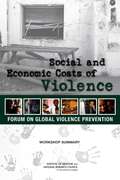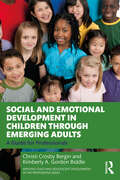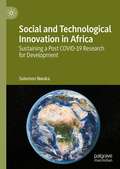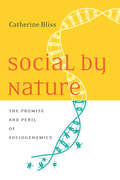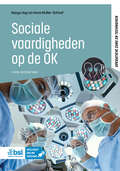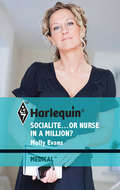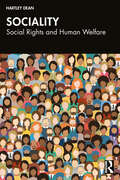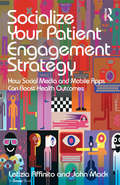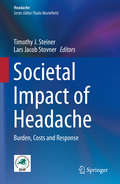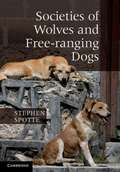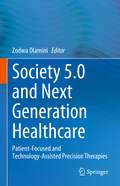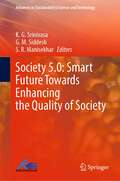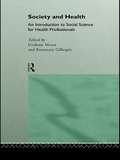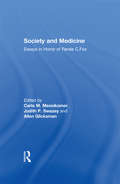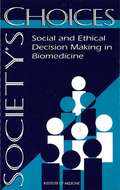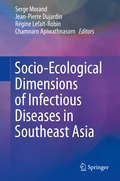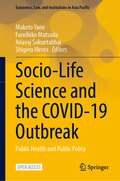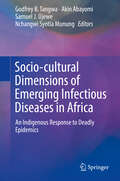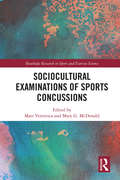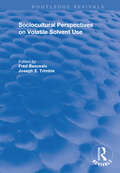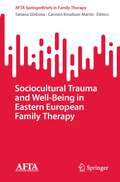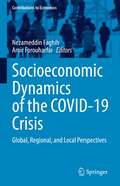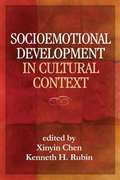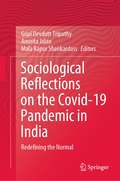- Table View
- List View
Social and Economic Costs of Violence
by Institute of Medicine Board on Global Health Forum on Global Violence Prevention Rachel M. Taylor Deepali M. PatelMeasuring the social and economic costs of violence can be difficult, and most estimates only consider direct economic effects, such as productivity loss or the use of health care services. Communities and societies feel the effects of violence through loss of social cohesion, financial divestment, and the increased burden on the healthcare and justice systems. Initial estimates show that early violence prevention intervention has economic benefits. The IOM Forum on Global Violence Prevention held a workshop to examine the successes and challenges of calculating direct and indirect costs of violence, as well as the potential cost-effectiveness of intervention.
Social and Emotional Development in Children through Emerging Adults: A Guide for Professionals (Applying Child and Adolescent Development in the Professions Series)
by Christi Crosby Bergin Kimberly A. Gordon BiddleThis concise guide offers an introduction to how children and young people develop social and emotional competence, and how they display appropriate social behavior and emotional expression at different ages.Explaining the role of adults in a range of contexts and settings, this volume offers strategies for supporting competence and highlights key topics, such as attachment, prosocial behavior, social perspective taking, ethnic identity, social and emotional learning, gender identity, parenting styles, and much more. Moving through the different ages of childhood to emerging adulthood, the authors detail social and emotional development and the development of the self. They also offer strategies to foster social–emotional competence through these different ages.Social and Emotional Development in Children through Emerging Adults is designed for students and professionals in psychological, educational, health and social work settings who want to support and nurture children and young people to ensure their needs are met.
Social and Technological Innovation in Africa: Sustaining a Post COVID-19 Research for Development
by Solomon NwakaThis book examines the landscape of sustained investment in research and innovation in Africa, which are critical for development. This cutting-edge analysis is based on empirical evidence and the author’s experience in managing health and related innovations on the continent and globally. It concludes, for the first time, that African innovation is largely driven by the principles of Social, rather than Technological innovation. The significance of this finding and the need to optimize, scale and sustain this dominant innovation is addressed in various chapters that analyze the status, challenges and opportunities. Particularly, the financing, collaboration and coordination patterns for these activities on the continent show a fragmented ecosystem that is largely dependent on external donors and aid. The importance of supportive policies, leadership and venture mechanisms that incentivizes public and private entities to innovate is further exemplified by the lessons of the COVID-19 pandemic. The book proposes mechanism to address identified challenges.
Social by Nature: The Promise and Peril of Sociogenomics
by Catherine BlissSociogenomics has rapidly become one of the trendiest sciences of the new millennium. Practitioners view human nature and life outcomes as the result of genetic and social factors. In Social by Nature, Catherine Bliss recognizes the promise of this interdisciplinary young science, but also questions its implications for the future. As she points out, the claim that genetic similarities cause groups of people to behave in similar ways is not new—and a dark history of eugenics warns us of its dangers. Over the last decade, sociogenomics has enjoyed a largely uncritical rise to prominence and acceptance in popular culture. Researchers have published studies showing that things like educational attainment, gang membership, and life satisfaction are encoded in our DNA long before we say our first word. Strangely, unlike the racial debates over IQ scores in the '70s and '90s, sociogenomics has not received any major backlash. By exposing the shocking parallels between sociogenomics and older, long-discredited, sciences, Bliss persuasively argues for a more thoughtful public reception of any study that reduces human nature to a mere sequence of genes. This book is a powerful call for researchers to approach their work in more socially responsible ways, and a must-read for anyone who wants to better understand the scholarship that impacts how we see ourselves and our society.
Sociale vaardigheden op de OK (Operatieve zorg en technieken)
by Marga Hop Irene Muller-SchoofDit leerboek biedt inzicht in de sociale vaardigheden die je nodig hebt voor het werken op een operatiekamercomplex. Het boek is geschreven voor de student-operatieassistent en -anesthesiemedewerker, maar ook zeer geschikt voor de zorgprofessional die in het werkveld van de OK zich verder wil ontwikkelen in (persoonlijke) sociale vaardigheden. Die vaardigheden variëren van gesprekken voeren met patiënten en collega’s, organiseren en plannen tot overleggen en vergaderen. Het boek is onderdeel van de reeks Operatieve Zorg & Technieken, die speciaal ontwikkeld werd voor de opleiding tot operatieassistent. Deze vijfde herziene druk van Sociale vaardigheden op de OK bestaat uit vijf delen, die grondig zijn aangepast om te voldoen aan de nieuwste inzichten. Deel I gaat in op het bouwen aan je eigen professionele identiteit. Deel II gaat over samenwerken in je beroep. Deel III geeft inzicht in gesprekken voeren met patiënten. Deel IV geeft verdieping in teamdynamiek. Deel V gaat over werkbegeleiding en deskundigheidsbevordering. Elk deel begint met een casus over de student Pieter, waarmee de lezer aan de hand van vele reflectievragen kan reflecteren op de situatie en op zichzelf. Vervolgens worden de hoofdstukken gepresenteerd, waarbij de leerstof wordt verduidelijkt door te verwijzen naar de casus. Voor extra verdieping zijn QR-codes toegevoegd door de hoofdstukken heen.
Socialite...Or Nurse in a Million?
by Molly EvansFrom designer dresses to surgical scrubs! Her Sterling-Thorne surname opens doors, and Vicky is passionate about nursing at Miguel Torres's community clinic. The Spanish doctor, however, isn't convinced she has what it takes. Vicky is determined to show him that behind her socialite reputation lies a heart of gold-a heart that's rapidly falling for her gorgeous new boss!
Sociality: Social Rights and Human Welfare
by Hartley DeanThis book develops a very particular concept of sociality: a holistic way of understanding how human beings have come to care about and collectively provide for their welfare as a species and to recognise each other’s needs in terms of shared social rights. It tells not so much a success story as a hopeful story. It provides a new way of looking at how our rights to life’s essentials have been in the past, are now and can in the future be understood. It is, potentially, a book for anyone interested in the human condition but will be especially interesting for those engaged in human service provision, community action, social development, welfare law and political debate, and particularly useful to students of social policy and human rights.It is a radically revised edition of Social Rights and Human Welfare, first published in 2015. It provides modified, re-organised and updated versions of chapters from that book while offering a wholly new underlying narrative through which further to develop and apply the author’s alternative theory of social rights. It is a book about the connections between social rights and human welfare; between theory and practice; between debate and reality in the spheres of human service provision and human livelihoods.
Socialize Your Patient Engagement Strategy: How Social Media and Mobile Apps Can Boost Health Outcomes
by John Mack Letizia AffinitoSocialize Your Patient Engagement Strategy makes the case for a fundamentally new approach to healthcare communication; one that mobilizes patients, healthcare professionals and uses new media to enable gathering, sharing and communication of information to achieve patient-centricity and provide better value for both organizations (in terms of profit) and patients (in terms of better service and improved health). Letizia Affinito and John Mack focus on three priority areas for actions: Improving Health Literacy (e.g. web sites; targeted mass digital campaigns), Improving Self-care (e.g. self-management education; self-monitoring; self-treatment), Improving Patient Safety (e.g. adherence to treatment regimens; equipping patients for safer selfcare). The authors explain the healthcare context to the digital communications revolution; the emerging digital marketing and communications techniques that enable this revolution and the core elements behind a patient-driven digital strategy. Drawing on the authors’ research and consulting practices, as well as on the practical experience of managers in medium-large companies worldwide, the book provides a proven framework for improving the development and implementation of patient-centered digital communication programs in healthcare organizations. It is an engaging how-to/how-not-to book which includes tips, advice, and critical reviews that every stakeholder dealing with the healthcare system must have in order to participate in the evolving healthcare system and be more active in making strategic patient-centered choices. Socialize Your Patient Engagement Strategy includes interviews with experts and leading case histories of successful digital communication programs in the healthcare arena. While there are books that focus on specific healthcare communicators within different types of organizations, in their book the authors recognize that effective patient-centric communication crosses all organizational boundar
Societal Impact of Headache: Burden, Costs and Response (Headache)
by Timothy J. Steiner Lars Jacob StovnerThis volume describes the impact of headache disorders on public health, and their adverse consequences for society. It opens with an overview of relevant headache disorders before describing, qualitatively, how the burdens attributable to these disorders fall upon adults, adolescents and children. In the second section, beginning with a methodological introduction discussing the principles and potential pitfalls of epidemiological studies assessing prevalence, headache-attributed burden and functional impact, the burdens of headache including financial cost are examined quantitatively and in detail. The third section critically reviews society’s response, its inadequacies and the scope for improvement. Topics here include the political failure to recognize the public ill-health and cost that are the consequences of inadequate headache care; the role of the WHO in addressing the problem; headache service organization, delivery and quality; and the effectiveness and cost-effectiveness of interventions. The book closes by considering the way forward. This volume contains important messages for primary care and is likely to be of even greater interest to headache specialists and those concerned with public health and health policy.
Societies of Wolves and Free-ranging Dogs
by Stephen SpotteWolves are charismatic emblems of wilderness. Dogs, which descended from wolves, are models of urbanity. Do free-ranging dogs revert to pack living or are their societies only reminiscent of a wolfish heritage? Focusing on behavioral ecology, this is the first book to assess societies of both gray wolves and domestic dogs living as urban strays and in the feral state. It provides a comprehensive review of wolf genetics, particularly of New World wolves and their mixture of wolf, coyote and dog genomes. Spotte draws on the latest scientific findings across the specialized fields of genetics, sensory biology, reproductive physiology, space use, foraging ecology and socialization. This interdisciplinary approach provides a solid foundation for a startling and original comparison of the social lives of wolves and free-ranging dogs. Supplementary material, including a full glossary of terms, is available online at www.cambridge.org/9781107015197.
Society 5.0 and Next Generation Healthcare: Patient-Focused and Technology-Assisted Precision Therapies
by Zodwa DlaminiThis book analyses the ability of technological advancements to represent, enhance, and empower multidisciplinarity in the context of Society 5.0. and next generation medicine. New technologies allow patients to communicate with medical personnel anytime, anywhere and shape the terrain of healthcare ecosystem at an unprecedented rate. Five main trends become apparent in this process: Hybrid care models combining virtual and in-person services, digitization of healthcare specialties, increased Artificial intelligence (AI) adoption, health systems moving to the cloud and advanced precision medicine.In its chapters the book dissects the important roles for technologies in areas such as digital twinning, big data, Internet of Things, AI, cyber-physical systems, blockchain technology to lead the healthcare digitalization envisioned in Society 5.0. Throughout the book the authors discuss how to incorporate these new technologies legally, ethically, safely, and securely and in keeping with the highest standards of human rights. It also advocates for the need for careful oversight and mindful allocation of resources and energy for sustainable development.This book, written by experts in the field from academia and industry, will appeal to researchers, healthcare professionals, policy makers, teachers and students interested in the ways healthcare is reorganized based on digital transformation efforts and the rethinking of care, including technologies.
Society 5.0: Smart Future Towards Enhancing the Quality of Society (Advances in Sustainability Science and Technology)
by K. G. Srinivasa G. M. Siddesh S. R. ManisekharThe book discusses Society 5.0 which fills the gap between cyber and physical space by providing a balanced environment between economic and social needs. The book is divided into two parts; part A focuses on various concepts related to Society 5.0 such as cyber space, physical space, information management and digital transformation. Part B discusses various integrated fields in Society 5.0, such as super-smart healthcare system, super-smart hospitality system, smart building, and transport management system. It also illustrates the concepts of big data, real-time analytics for smart Society 5.0 with an insight of real-time case studies.
Society and Health: An Introduction to Social Science for Health Professionals
by Graham Moon Rosemary GillespieA concise introduction to the central issues concerning health and health care in contemporary society, Society and Health is written for all health professionals undergoing basic training. It explains social science concepts and theories and shows their relevance to work in health settings.Each chapter is short and focused on key learning points. 'concept boxes' highlight the main themes and facilitate revision exercises and activities enable students to apply knowledge to practice assumes no previous knowledge ideal for common foundation programmeguided further reading
Society and Medicine: Essays in Honor of Renee C.Fox
by Judith P. Swazey"The essays in this volume pay tribute to the achievements of RenÚe C. Fox in the fields of medicine and sociology. Many of the contributors are Fox's colleagues and former students from medicine, sociology, nursing, and bioethics. The title--Society and Medicine--reflects the leitmotif in Fox's work: her studies of and teaching about the nature of medicine and medical research; the training and work of their practitioners; the interrelationships between medicine and the societies and cultures of which it is a part; and, above all, the moral and spiritual dimensions of the healing arts."
Society's Choices: Social and Ethical Decision Making in Biomedicine
by Harvey V. Feinberg Ruth E. Bulger Elizabeth M. BobbyBreakthroughs in biomedicine often lead to new life-giving treatments but may also raise troubling, even life-and-death, quandaries.Society's Choices discusses ways for people to handle today's bioethics issues in the context of America's unique history and culture--and from the perspectives of various interest groups.The book explores how Americans have grappled with specific aspects of bioethics through commission deliberations, programs by organizations, and other mechanisms and identifies criteria for evaluating the outcomes of these efforts. The committee offers recommendations on the role of government and professional societies, the function of commissions and institutional review boards, and bioethics in health professional education and research.The volume includes a series of 12 superb background papers on public moral discourse, mechanisms for handling social and ethical dilemmas, and other specific areas of controversy by well-known experts Ronald Bayer, Martin Benjamin, Dan W. Brock, Baruch A. Brody, H. Alta Charo, Lawrence Gostin, Bradford H. Gray, Kathi E. Hanna, Elizabeth Heitman, Thomas Nagel, Steven Shapin, and Charles M. Swezey.
Society, Culture and the Auditory Imagination in Modern France
by Ingrid SykesThis book examines the striking way in which medical and scientific work on hearing in eighteenth and nineteenth-century France helped to shape modern French society and culture. Contemporary scientists and anatomists had to come to terms with a new kind of transformative physiology within the material site of the human ear, one that had the potential to construct space and place in the most powerful way imaginable. Auditory medical specialists found themselves at the center of pivotal philosophical, political and social debates on how the individual citizen might use their ears to reach out to those around them constructing broader, protective models of social reform. Sykes makes the case that of all the senses hearing offered the greatest resources for remodelling the idea of the universal human condition within the modern French historical setting.
Socio-Ecological Dimensions of Infectious Diseases in Southeast Asia
by Serge Morand Jean-Pierre Dujardin Régine Lefait-Robin Chamnarn ApiwathnasornThis book pursues a multidisciplinary approach in order to evaluate the socio-ecological dimensions of infectious diseases in Southeast Asia. It includes 18 chapters written by respected researchers in the fields of history, sociology, ecology, epidemiology, veterinary sciences, medicine and the environmental sciences on six major topics: (1) Infectious diseases and societies, (2) Health, infectious diseases and socio-ecosystems; (3) Global changes, land use changes and vector-borne diseases; (4) Monitoring and data acquisition; (5) Managing health risks; and (6) Developing strategies. The book offers a valuable guide for students and researchers in the fields of development and environmental studies, animal and human health (veterinarians, physicians), ecology and conservation biology, especially those with a focus on Southeast Asia.
Socio-Life Science and the COVID-19 Outbreak: Public Health and Public Policy (Economics, Law, and Institutions in Asia Pacific)
by Makoto Yano Fumihiko Matsuda Anavaj Sakuntabhai Shigeru HirotaThis open access book presents the first step towards building socio-life science, a field of science investigating humans in such a way that both social and life-scientific factors are integrated. Because humans are both living and social creatures, a human action can never be understood fully without knowing both the biological traits of a person and the social scientific environments in which he exists. With this consideration, the editors of this book have initiated a research project promoting a deeper and more integrated understanding of human behavior and human health. This book aims to show what can, and could be, achieved through our interdisciplinary project. One important product is the newly formed three-party collaboration between Pasteur Institut, Kyoto University, and the Research Institute of Economy, Trade and Industry. Covering many different fields, including medicine, epidemiology, anthropology, economics, sociology, demography, geography, and policy, researchers in these institutes, and many others, present their studies on the COVID-19 pandemic. Although based on different methodologies, the studies show the importance of behavioral change and governmental policy in the fight against a huge pandemic. The book explains the unique genome cohort–panel data that the project builds to study social and life scientific aspects of humans.
Socio-cultural Dimensions of Emerging Infectious Diseases in Africa: An Indigenous Response to Deadly Epidemics
by Godfrey B. Tangwa Akin Abayomi Samuel J. Ujewe Nchangwi Syntia MunungThis volume examines the most important socio-cultural, political, economic, and policy issues related to emerging infectious diseases in Africa. The volume covers the work of the Global Emerging Pathogens Treatment Consortium (GET); it looks at the challenges of science education and communication in Africa, the global health and governance of pandemics and epidemics, and more. It looks beyond such threats as Ebola, SARS, and Zika to consider the ways communities have sought to contain these and other deadly pathogens. The chapters provide a better understanding of a global health problem from an African perspective, which help clarify to readers why some responses have worked while others have not. Overall, the volume captures the state of the art, science, preparedness, and evolution of a topic important to the health of Africa and the world. It has a broad appeal across disciplines, from medical science and biomedical research, through research ethics, regulation and governance, science and health communication, social sciences, and is also of interest to general readers.
Sociocultural Examinations of Sports Concussions (Routledge Research in Sport and Exercise Science)
by Matt Ventresca Mary G. McDonaldSport’s "concussion crisis" has been characterized by controversial scientific discoveries, athlete suicides, and high-profile lawsuits involving professional sports leagues, while provoking widespread media coverage, changes to game rules, and debate about the future of many popular sports. Sociocultural Examinations of Sports Concussion is the first edited collection to bring together multiple sociocultural perspectives on sports concussion that interrogate the social, economic, political, and historical forces shaping the cultural impacts of these injuries. Each of the ten chapters moves beyond biomedical or neuroscientific paradigms to critically examine a specific intersection of sociocultural factors influencing public perceptions about concussion or athlete experiences of brain injury. These include analyses of media and advertising, medical treatment and diagnostic protocols, gender and masculinity, developments in equipment and scientific models, economics and labor politics, understandings of trauma and recovery, public health philosophies, and disciplinary differences in framing the ontologies of concussion. Drawing from a wide range of theoretical and methodological approaches, Sociocultural Examinations of Sports Concussion offers a diverse set of analyses examining brain injuries as cultural and embodied phenomena affecting more than just athletes’ brains, but also embedded within and (re)shaping meanings, identities, and social contexts. It is valuable reading for graduate students and researchers interested in the experience and treatment of sports concussion, sports sociology, and sports technology.
Sociocultural Perspectives on Volatile Solvent Use
by Joseph Trimble Fred BeauvaisVolatile solvent abuse is a growing problem that receives little research or treatment attention compared with other drug abuse problems. Whereas prevention programs and other societal factors are reducing the experimentation with a majority of drugs, solvent abuse appears to run its own independent course. Sociocultural Perspectives on Volatile Solvent Use gives you groundbreaking, vital information about the problem of solvent abuse among American Indian and Alaska Native youth. Drug treatment providers, clinical practitioners, and the general community can use the information in this book to understand the patterns of solvent abuse and implement prevention and treatment strategies for other groups within the larger culture. Among the first book-length publications on this problem, this volume helps you acknowledge the epidemic levels of solvent abuse and treat the problem with the urgency it deserves. Sociocultural Perspectives on Volatile Solvent Use defines the three subtypes of solvent users (young inhalant users, adolescent polydrug users, and adult users), presents a biobehavioral model of drug-taking behavior, and identifies the principal factors related to volatile solvent use. You will also learn the answers to prevention and treatment questions such as: Why does the use of solvents often occur in rapidly cycling epidemics? Can effective policy measures be introduced that will limit the availability of inhalable solvents? What is the optimal length of time needed for effective treatment? What level and type of neurological damage is caused by solvents, and is this damage reversible? What are the unique issues that must be addressed in relapse prevention and aftercare plans? The peculiar nature of solvent use places it outside the normal range of substance abuse research; thus, knowledge of the phenomenon is quite limited. Sociocultural Perspectives on Volatile Solvent Use addresses this challenge by bringing together a number of solvent abuse researchers to discuss the problem, kindle ideas and interest among others to explore this drug-taking behavior, and show you the clear need for continued inquiry into the phenomena of solvent use and abuse.
Sociocultural Trauma and Well-Being in Eastern European Family Therapy (AFTA SpringerBriefs in Family Therapy)
by Carmen Knudson-Martin Tatiana GlebovaThis book examines the effects of sociocultural trauma throughout the 20th century on interpersonal and family relationships in five Eastern European countries, drawing on the perspectives of mental health practitioners. Chapters employ a systemic perspective to explore the unique social, political, and cultural contexts that influence relationships in each country with a particular focus on implications for psychological and relational well-being. The volume demonstrates the importance of examining the cultural and sociocontextual nuances and complexity that may influence the impact of historical events on relationships, elucidating similarities and differences among countries in how the collective trauma has influenced them. It assists family therapists and other mental health practitioners in recognizing cultural and social factors that may influence their work with families, individuals, or couples living in these countries or who have immigrated from them.Key areas of coverage include:Descriptions of each country’s experience of sociocultural trauma and the current social-cultural-economic-political contexts.Impact of trauma on interpersonal relationships across various social locations and national and ethnic identities within the existing borders.Current challenges, recommendations for clinical practice, and future directions for research and practice. Sociocultural Trauma and Well-Being in Eastern European Family Therapy is an essential resource for clinicians, therapists, and practitioners as well as researchers, professors, and graduate students in family studies, clinical psychology, and public health as well as all interrelated disciplines.
Socioeconomic Dynamics of the COVID-19 Crisis: Global, Regional, and Local Perspectives (Contributions to Economics)
by Nezameddin Faghih Amir ForouharfarThis book depicts and reveals the socioeconomic dynamics of the COVID-19 crisis, and its global, regional, and local perspectives. Explicitly interdisciplinary, this volume embraces a wide spectrum of topics across economics, business, public management, psychology, and public health. Written by global experts, each chapter offers a snapshot of an emerging aspect of the COVID-19 crisis for the benefit of academics and students, as well as the institutional, economic, social, and developmental policymakers and health practitioners on the ground.
Socioemotional Development in Cultural Context
by Kenneth Rubin Xinyin ChenFilling a significant gap in the literature, this book examines the impact of culture on the social behaviors, emotions, and relationships of children around the world. It also explores cultural differences in what is seen as adaptive or maladaptive development. Eminent scholars discuss major theoretical perspectives on culture and development and present cutting-edge research findings. The volume addresses key aspects of socioemotional functioning, including emotional expressivity, parent-child and peer relationships, autonomy, self-regulation, intergroup attitudes, and aggression. Implications for culturally informed intervention and prevention are highlighted
Sociological Reflections on the Covid-19 Pandemic in India: Redefining the Normal
by Mala Kapur Shankardass Gopi Devdutt Tripathy Anurita JalanThis book presents a sociological study of the COVID-19 pandemic in the context of India. It invites readers to understand disasters and crises as triggers of radical transformations in society, changing the very nature of every day and the meaning of normal. It discusses the processes through which society accepts, internalizes and reinvents a new way of life. It provides insights into its impact on the individual, family, economy and the state and the relationships not only between them but also within them. The chapters draw attention to the concerns of the vulnerable sections of the population – the aged, children, women, the disabled, migrant labour and the economically backward classes. The chapters are written in an engaging style, and each chapter investigates the way societies think about the risk, threat and harm and the ways to navigate crises of all kinds. As such, the book provides a key read for academics, students and administrators, as well as general readers confronted by an existential crisis caused by the pandemic.
